|
Haynes
Automotive Company
Haynes Stellite Company During World War Two
Kokomo, IN
1912-Current
This page added 12-23-2023.
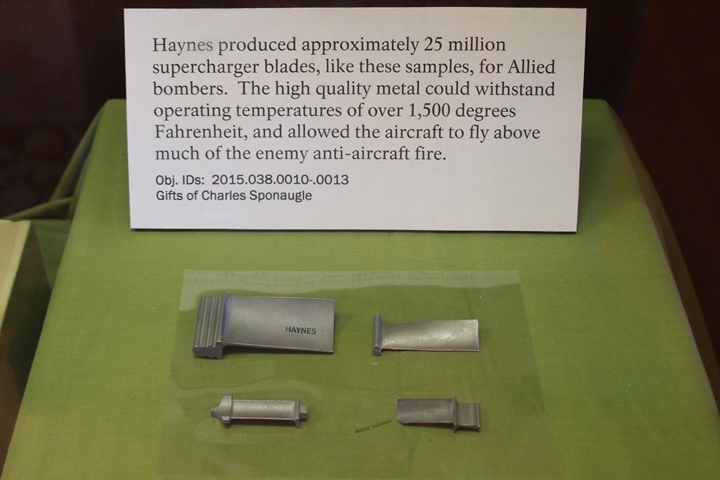
This display of four turbo supercharger blades, or buckets, was a total
surprise to me when I visited the Howard County Historical Museum in
February 2023. Until I saw this display, I was unaware of the
existence of the Haynes Stellite Company in Kokomo, IN, and the
company's importance in the production of the turbo supercharger blades.
In spite of their
small size, Haynes Stellite turbo supercharger buckets were a very
important product in helping to win World War Two.
But first we will take a deeper look at Elwood Haynes, who invented Stellite,
and his relationship with Kokomo, IN.
Elwood Haynes is to Kokomo, IN what R.E. Olds is
to Lansing, MI, and Henry Ford is to Detroit, MI. All three
started automobile companies in each of their respective cities.
Today, each of those cities still have auto companies as the result of these automotive pioneers. R.E. Olds was responsible
for Oldsmobile and the Reo Auto Car Company in Lansing. While both
Oldsmobile and Reo have gone out of business, Lansing has two relatively
new General Motors assembly plants in the area. These plants are
the result of R.E. Olds bringing Oldsmobile to Lansing. Both of
the new assembly plants were built while other cities were losing their
GM plants.
The Ford Motor Car Company still has a huge
presence in the Detroit area. Henry Ford's legacy still lives on
in southeast Michigan and is responsible for many jobs in the area.
Elwood Haynes was the second person in the
United States to design and drive an automobile. He did this in
Kokomo, IN in 1894. In 1895, Elwood Haynes and Elmer Apperson
began the Haynes-Apperson Company with the goal of producing fifty
vehicles in 1895. This was the first company in the United States
to begin production of automobiles. In 1901, Mr. Apperson left the
company to begin a new automobile company with his brother in Kokomo,
the Apperson Brothers Automobile Company. Mr. Haynes continued on
with the original company and in 1903 renamed his company the Haynes Automotive Company.
The company continued until 1925 when it went out of business.
However, Elwood Haynes' legacy and his
long term impact on Kokomo, IN does not end with the closing of his
automobile company. It opened a new chapter in 1930 with the
arrival of the Chrysler transmission plant that occupied the former
Haynes Automobile Company factory on Home Avenue. Chrysler and the
various companies that have purchased the brand name have not only stayed in
Kokomo, but built new factories in the area. Currently, a joint
effort between Stellantis and Samsung SDI is building an electric vehicle battery plant
that will employ 1,400 workers just north of Kokomo. The demise of the Haynes
Automobile Company in 1925 allowed for a state-of-the-art automotive
electric vehicle battery plant to be built in the Kokomo area 100 years
later.
.
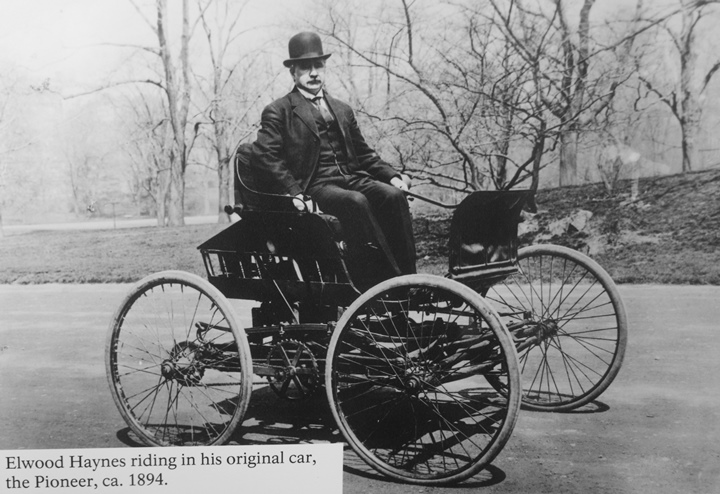
This image of Mr. Haynes is courtesy of the
Howard County Museum, Kokomo, IN.
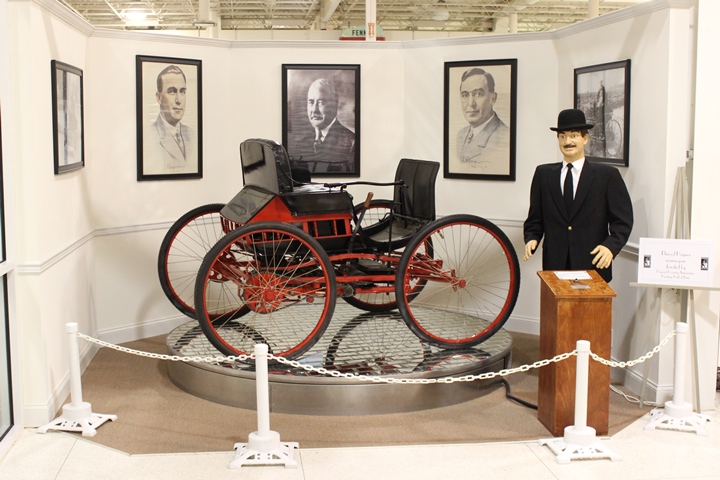
The "Pioneer" was Elwood Haynes' idea.
However, it was a local mechanic by the name of Elmer Apperson that
owned the Riverside Machine Shop in Kokomo that built the vehicle.
On July 10, 1894, the "Pioneer" took a trip down Pumpkinville
Pike in Kokomo. This is a replica that was on display at the
former Kokomo Automobile Museum. The original was given to the
Smithsonian Museum by Mr. Haynes. Author's photo.
More information on the Haynes Automobile
Company is in the link at the top of this page.
Mr. Haynes
was also very interested in metallurgy. After much experimentation
he
developed several new metals. These led to the creation of the Haynes Stellite Company in Kokomo in 1912. While many companies in Kokomo
have come and gone, Haynes International, the name of the former Haynes
Stellite Company, is still in Kokomo. Unlike many companies
described on this website, it has not moved out of its place of origin
for the cheap labor of the south. It has stayed in Kokomo and
built new plants, a world headquarters, and research center in the city.
Haynes International needs to be recognized for being a good Kokomo
corporate citizen. This is the second of Elwood Haynes' continuing
presence in the area.
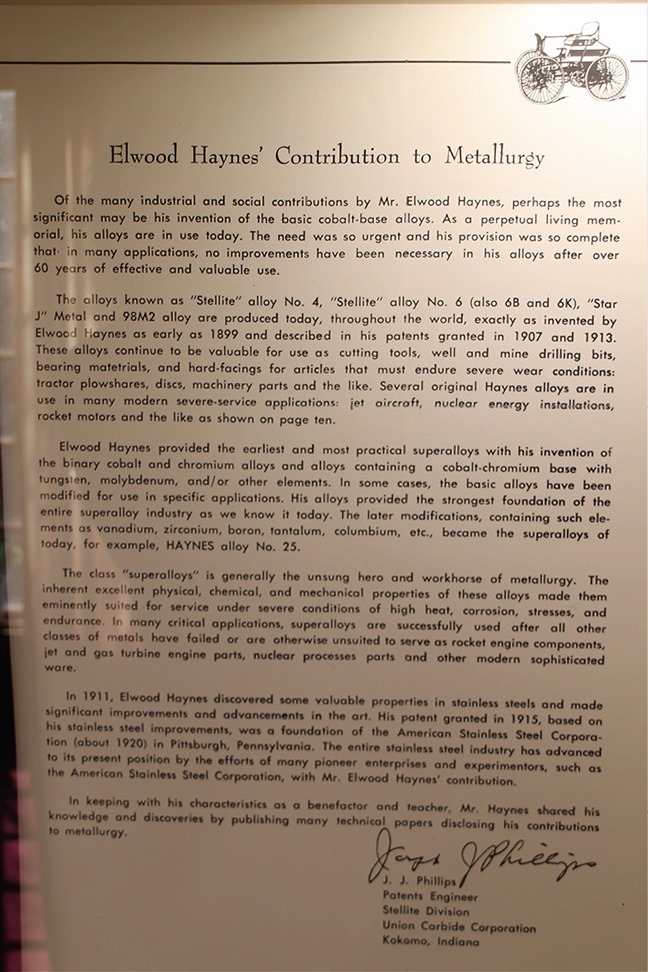
This description of Mr. Haynes' work in
metallurgy is from the Elwood Haynes Museum.
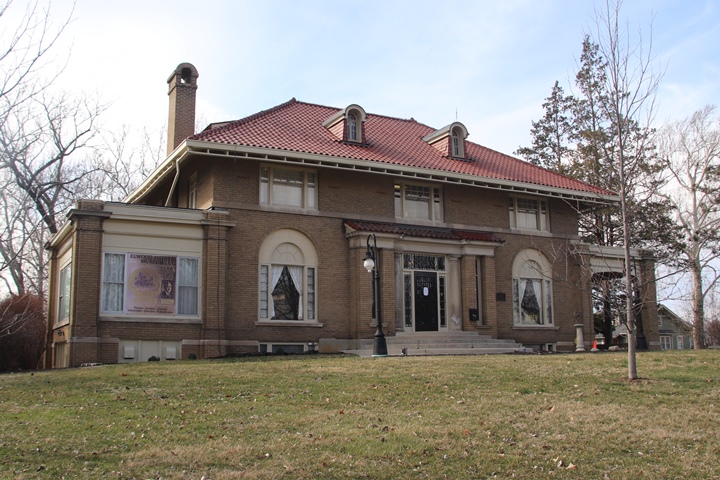
This is the former Elwood Haynes mansion in
Kokomo, IN. Currently, it is a very nice museum that tells the story
of Elwood Haynes. I have found that Kokomo is very cognizant of
its history. This is one of two excellent local history museums in
Kokomo. Author's photo.
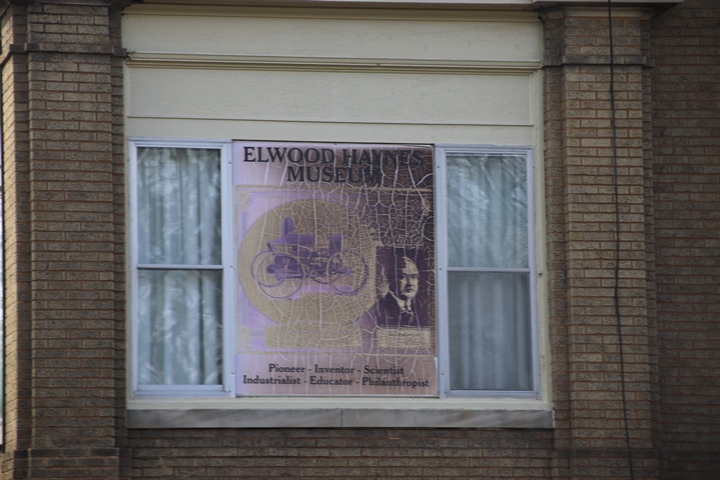
Author's photo.
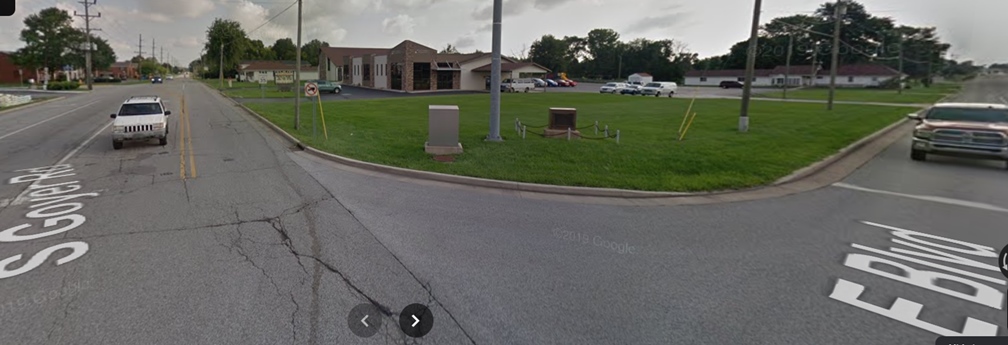
In the northeast corner of the intersection
of South Goyer Road and E Blvd. is a marker commemorating Mr. Haynes'
first automobile ride in the "Pioneer." It is my understanding
that one of these two streets used to be Pumpkinville Pike. Image
courtesy of Google Maps.
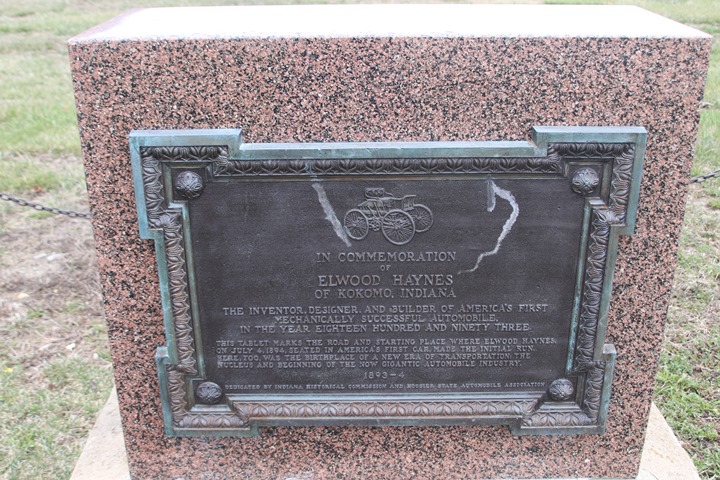
Author's photo.
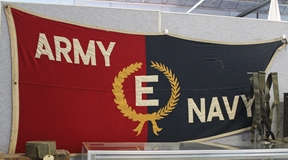
The Haynes Stellite Company won the
Army-Navy "E" award twice during World War Two.
The company won the first award in February 1945.
It won the second award at the end of the war in August 1945
Haynes Stellite Company World War Two
Products: The most well-known product the company made for the
war effort was the 25 million turbo supercharger buckets it produced.
However, further research shows the company's alloys were used in a wide
variety of products for the war effort.
Haynes Stellite Company had $4,512,000
in major contracts during the war. The largest contract was with
army ordnance for $3,797,000 for M2 gun part castings. This was
84% of the company's major contracts. The three other army
ordnance contracts also appear to be M2 gun casting contracts. The
company began making the inner linings for M2 .50 caliber machine guns
for aircraft use. Previous linings were burning out during operation, and
it was not possible to change barrels in flight. Stellite inner
linings from Haynes were the solution. The company also provided
linings for M2 machine guns for both the Korean and Vietnam wars.
The company had four contracts with the Navy
for cutting tools totaling $510,000 or 11% of total contracts.
Table 1 - Haynes Stellite
Company's
Major World War Two Contracts
The information below
comes from the "Alphabetical Listing of Major War Supply
Contracts, June 1940 through September 1945." This was
published by the Civilian Production Administration, Industrial
Statistics Division. |
|
Product - Customer |
Contract Number |
Contract Amount |
Contract Awarded
Date |
Completion
Date |
| Tools - Navy |
NOS-891564 |
$60,000 |
9-1941 |
3-1942 |
| Tools - Navy |
NOS-12554 |
$250,000 |
9-1942 |
10-1943 |
| Cutting Tools -
Navy |
NXS-36618 |
$150,000 |
9-1943 |
9-1944 |
| Metal Castings -
Army Ordnance |
19058-ORD-2824 |
$105,000 |
9-1944 |
2-1945 |
| Steel Cutting
Tools - Navy |
XSX-80125 |
$50,000 |
9-1944 |
9-1945 |
| Gun Part Castings
M2 - Army Ordnance |
33008-ORD-1677 |
$3,797,000 |
12-1944 |
12-1945 |
| Liner Castings-
Army Ordnance |
11070-ORD-3988 |
$100,000 |
7-1945 |
12-1945 |
| Total |
|
$4,512,000 |
|
|
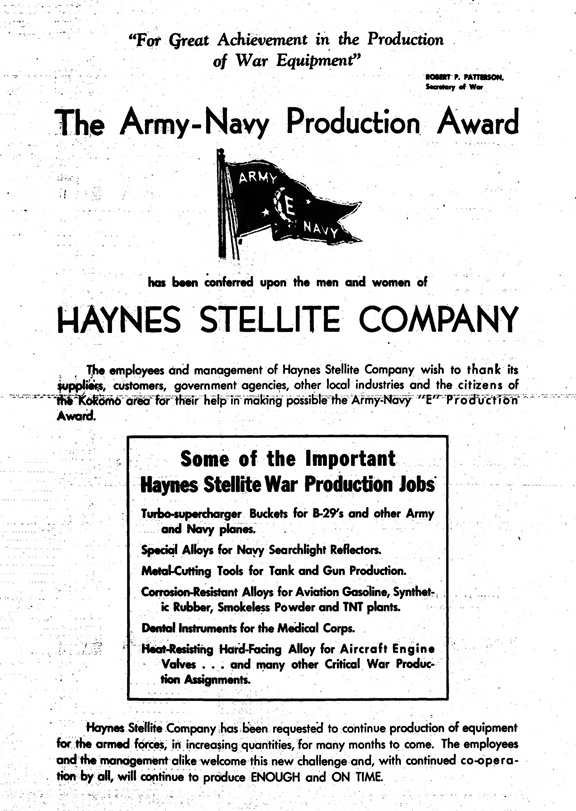
This advertisement was placed in the
February 15, 1945, edition of the Kokomo Tribune announcing the company's
winning of the Army-Navy "E" award. The listing of war production
jobs allows more insight into how the company helped win World War Two.
The first item listed is for turbo
supercharger buckets for Army and Navy Aircraft. This product will
be examined in detail next.
The Haynes Stellite Company and the General Electric Turbo Supercharger:
Word Use: During World War Two, the exhaust driven devices
that delivered increased amounts of air to American aircraft engines
were called turbo superchargers. Current terminology for these
devices is turbo chargers or just plain turbos. This website will
use the World War Two nomenclature for the device.
The term turbo is added to the supercharger to
distinguish it from a supercharger. Superchargers were integral to
the aircraft engine itself and were gear driven by the engine.
Turbo superchargers were not located in the engine but in the exhaust
system. Hot exhaust gas from the engine drove the turbine that
caused the turbo supercharger to spin. The turbines were able to
spin due to the hot exhaust gas hitting the Haynes Stellite buckets, or
blades, in the turbine wheel.
The General Electric turbo supercharger was an
important component in five USAAF aircraft and two U.S. Navy aircraft.
It was used in the USAAF's B-29, as noted in the advertisement above
along with the B-17, B-24, P-38, and P-47. The U.S. Navy
used it in the PB4Y-1.
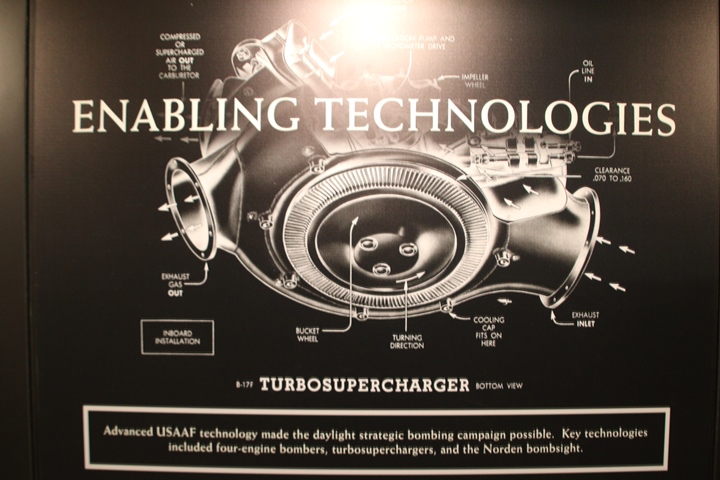
This information board is part of the
displays surrounding the B-17F "Memphis Belle" at the National Museum of
the United States Air Force in Riverside, OH. The information
board notes that the turbo supercharger was a key technology for
daylight strategic bombing along with four-engine bombers and the Norden
bombsight. This places the turbo supercharger in a rather
exclusive club. Author's photo.
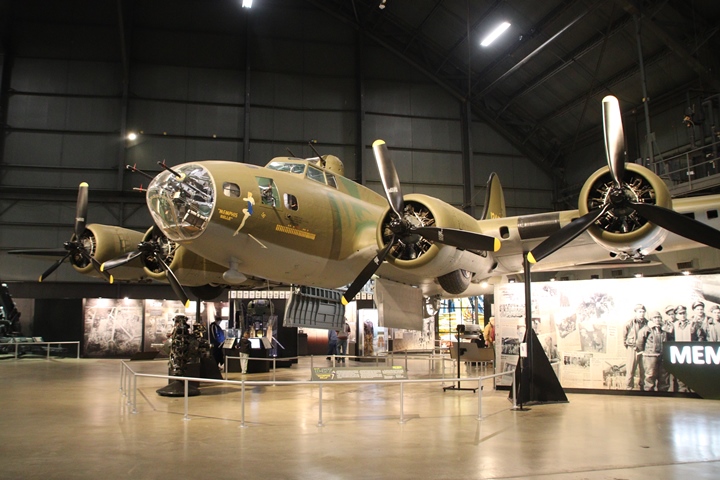
The B-17 series aircraft used by the Army
Air Forces during World War Two all came with four GE turbo
superchargers, one for each engine. Author's photo.
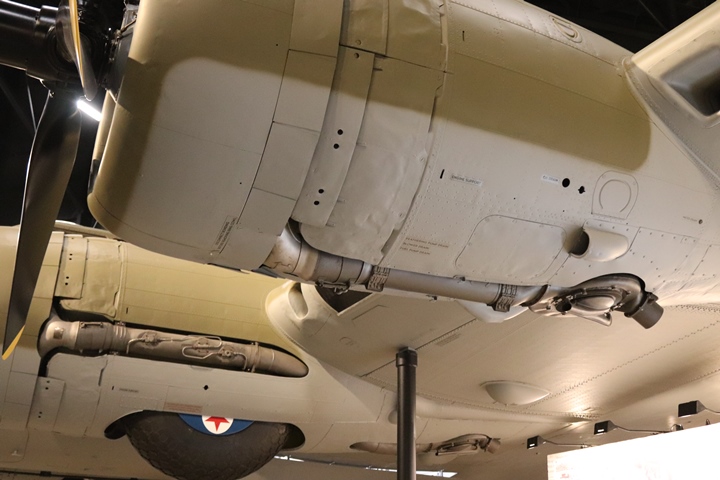
The turbo superchargers can be seen here in
the "Memphis Belle." The nearest one is located under the outboard
engine. The exhaust pipe can be seen running along the bottom of
the nacelle to the turbo supercharger. On the inboard engine, the
exhaust pipe is routed beside the landing gear and then through the
nacelle to the turbo supercharger. Author's photo.
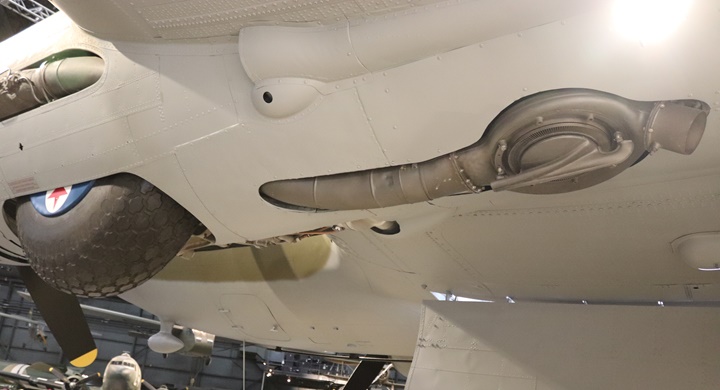
This image is a closer view of the B-17's interior engine turbo supercharger
configuration. Not
counting spares, 50,768 turbo superchargers were needed for B-17 production
during World War Two. Author's photo.
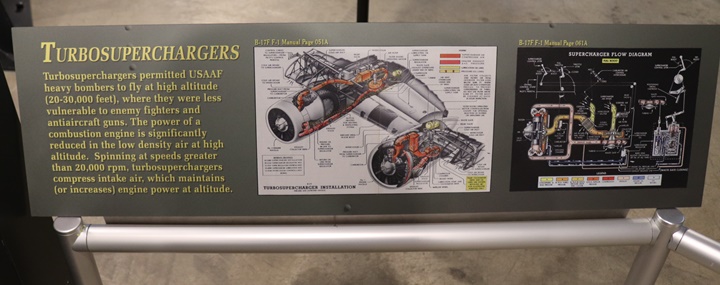
The left hand section of the information
board at the "Memphis Belle" gives a concise explanation of why the
turbo supercharger was important and how it worked. Author's photo.
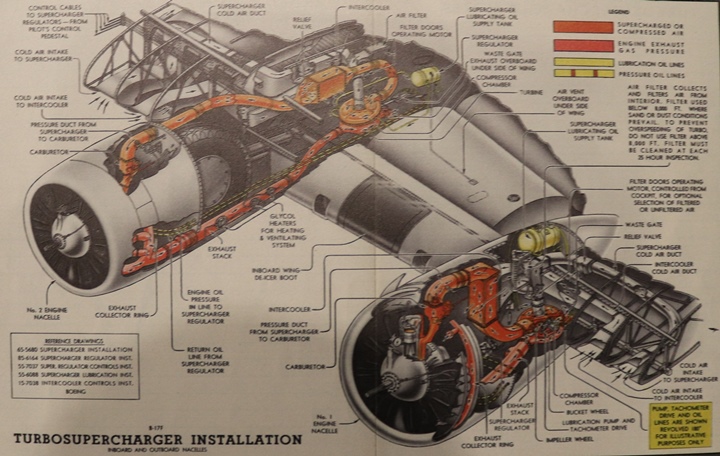
This display shows the routing of the
exhaust gases in red, running from the engine exhaust to the turbo
supercharger along the bottom of the engine nacelle. The
compressed air runs from the top of the turbo supercharger in
orange, which is nearly indistinguishable from the red, to the engine
intakes. Author's photo.
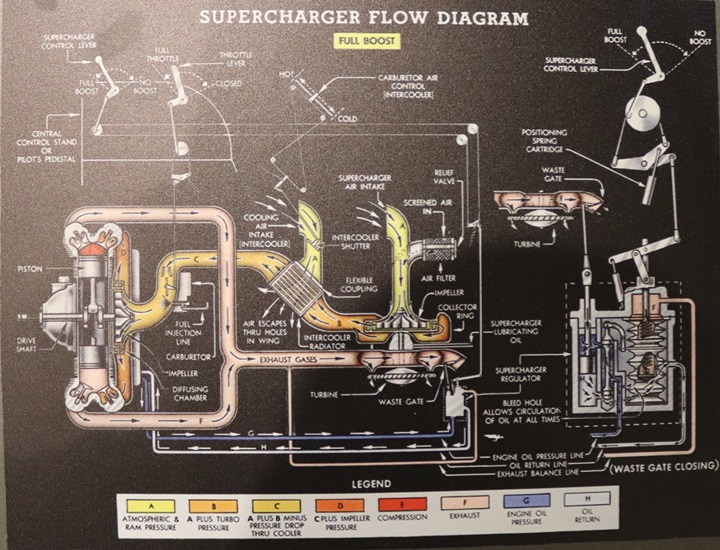
This image shows the side cut-away view of
the system. Author's photo.
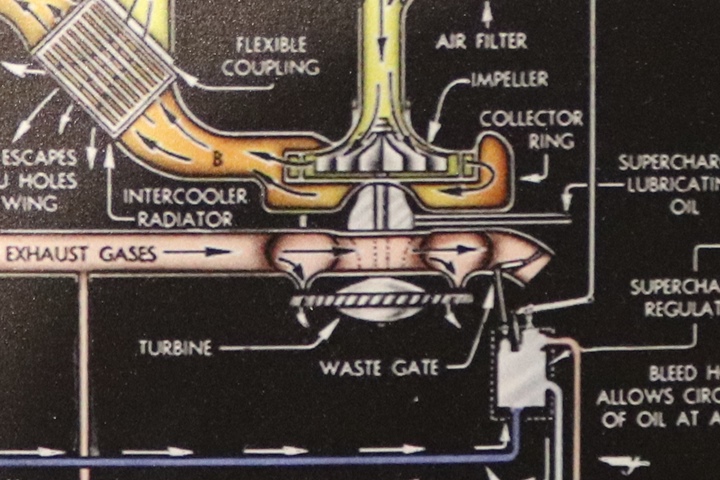
The enlargement of the above image shows the
area of interest for the Haynes Stellite turbine bucket or turbine
blade. Note that the exhaust can flow down the exhaust pipe and
bypass striking the turbine if the waste gate is completely open.
As the waste gate closes while the aircraft climbs in altitude, hot exhaust
air is then directed to the Haynes Stellite turbine buckets, causing
the turbine to spin, which allows the impeller to send compressed air to
the engine. Author's photo.
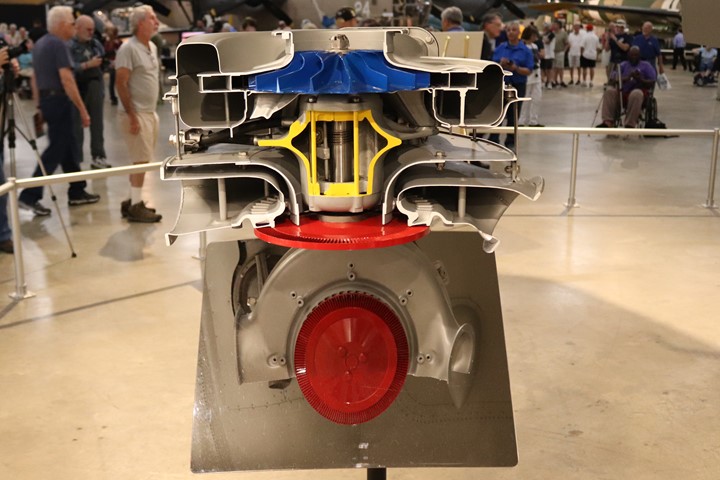
The National Museum of the United States Air
Force has the best display I have found on the GE turbo supercharger.
It has the information boards shown previously, and it also has this
excellent cut-away of an actual turbo supercharger. The museum has
installed a mirror underneath the turbine which helps explain
the function and importance of the Haynes Stellite turbine buckets.
The red paint identifies the hot turbine while blue indentifies the cold
impeller in the unit. Author's photo.
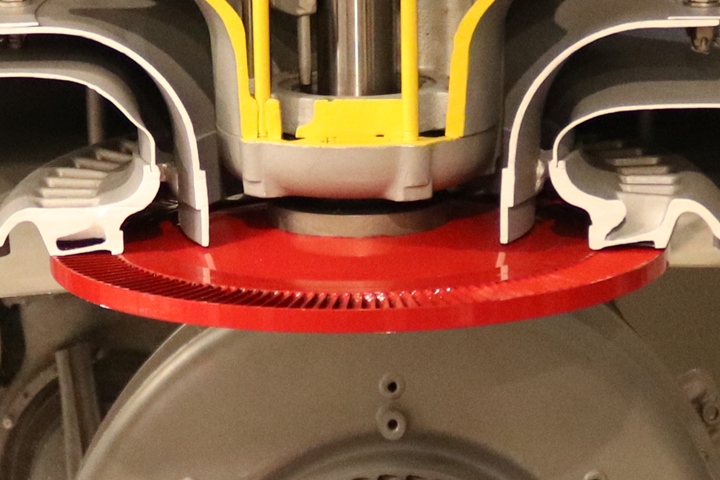
The turbine buckets or blades can be seen on
the outer diameter of the turbine wheel. They are oriented at the
proper angle to cause the turbine wheel to spin at up to 20,000
rpms when the waste gate is completely closed. Author's photo.
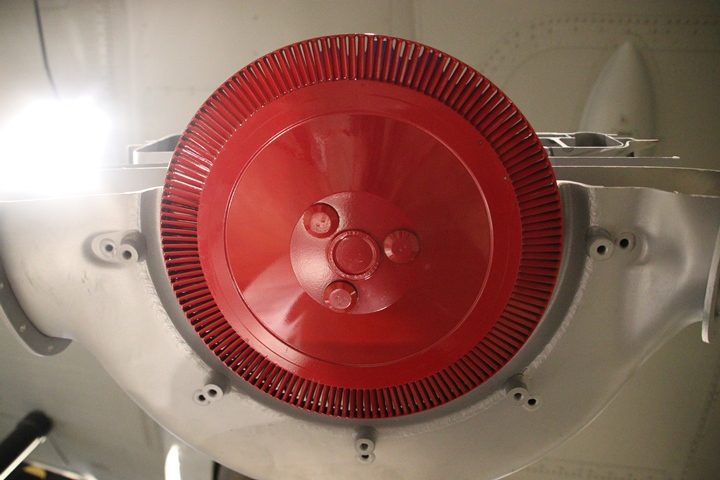
This image shows the entire turbine wheel
and the Haynes Stellite buckets. Author's photo.
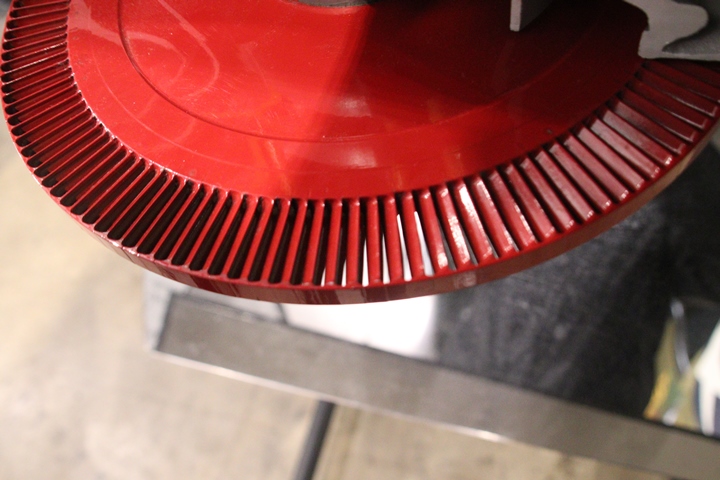
The manufacturing of the turbo supercharger
buckets was an intensive and careful process to create a properly
configured bucket. Each bucket had to be the exact size,
configuration, and weight for it to function properly in and operate in the
turbine wheel. Author's photo.
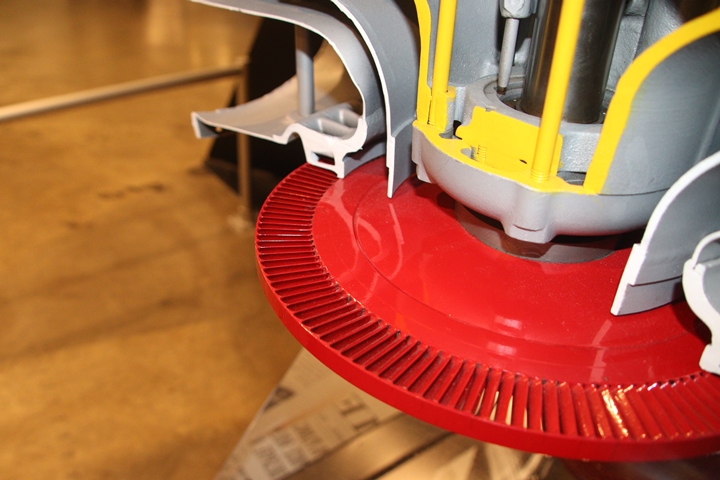
The turbine buckets operated in an extreme
environment with 1,500 degree Fahrenheit temperature exhaust gases
blowing on it from the engine; while on the exterior side, the
temperatures were minus 60 degrees below zero Fahrenheit at 25,000 feet
of altitude. The
Haynes Stellite bucket not only had to operate in the extreme
temperatures but at the 20,000 rpms. Any non-conformity to
specification would cause the bucket to fail and the high speed turbine
wheel to disintegrate. The failure of something as small as the
turbine bucket could cause the loss of an aircraft and its crew as the
aircraft could no longer operate at the high altitudes needed for combat
missions. Author's photo.
For B-17s, B-24s, B-29s, P-38s, and P-47s the failure of a turbine
bucket in the aircraft's engine was similar to the classic poem by Anon
on the loss of a nail in a horse shoe. During the air war in
Europe, bombers flew in tight formation in order for the gunners on
several aircraft to work together in defending against attacking
fighters. If a bomber had to drop out of formation due to any
problem, including a non-functioning turbo supercharger, it then became
easy prey for enemy fighters. If P-47 and P-38 fighters assigned
to protect American bombers had to return home due to a non-functioning
turbo supercharger, there are less than the necessary fighters to
protect the bombers. The number of aircraft lost due not enough
fighters and bombers working in unison could be higher than if all the
aircraft were contributing to the battle.
"For Want of a Nail
by Anon
For want of a nail the shoe was lost.
For want of a shoe the horse was lost.
For want of a horse the rider was lost.
For want of a rider the battle was lost.
For want of a battle the kingdom was lost.
And all for the want of a horseshoe nail."
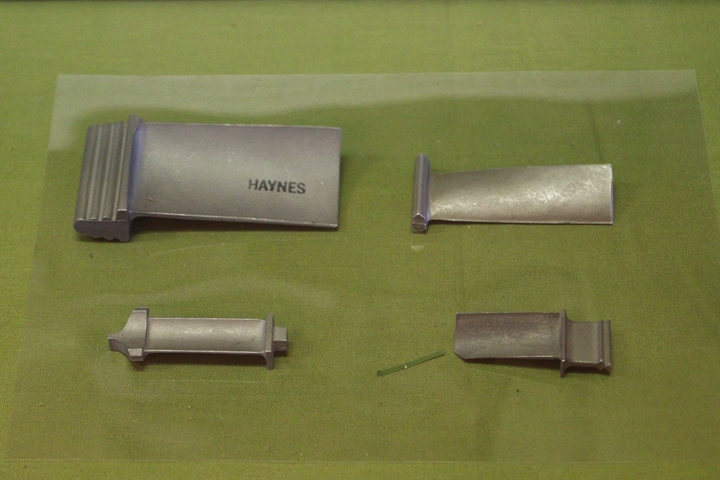
This is an enlargement of the previous photo
of the Haynes Stellite bucket display at the Howard County Historical
Museum. At peak production during World War Two, the company was
turning out 2,000,000 of these per month. Author's photo.
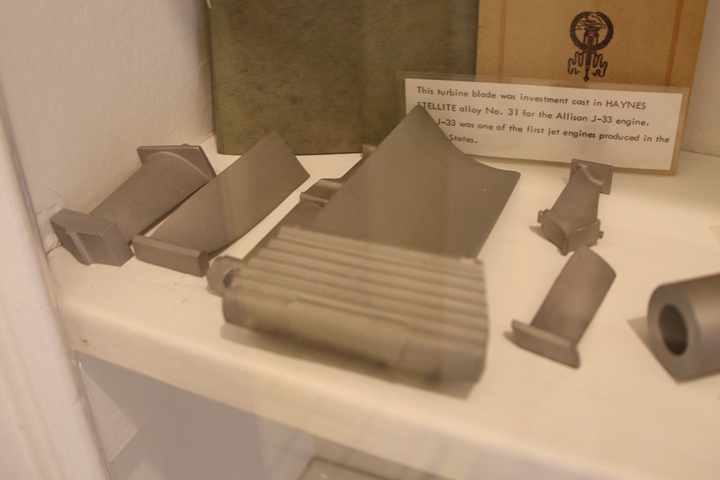
This and the next photo are from the Elwood
Haynes Museum in Kokomo, IN. Not only did the company produce the
bucket for the GE turbo superchargers, but Haynes Stellite metals were
also used in the manufacture of jet engine blades for the early jet engines
that were being built during the war. Author's photo.
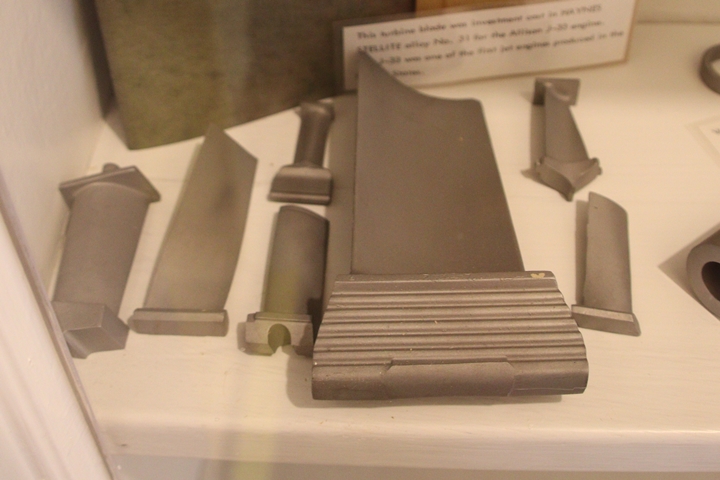
Author's photo.
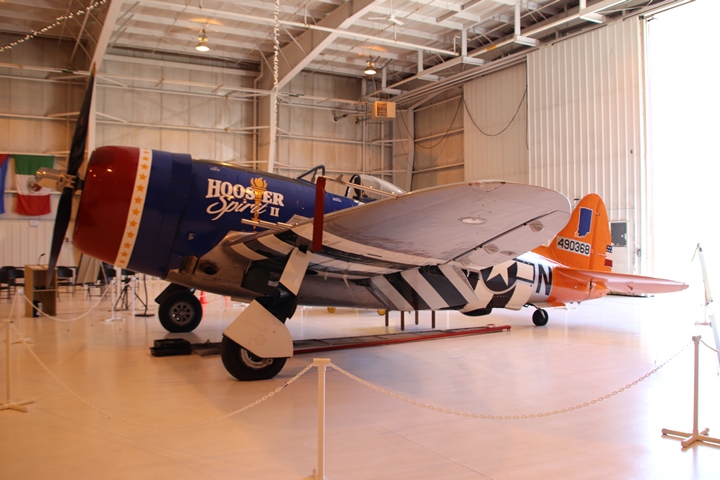
The P-47 was an important American fighter
aircraft that relied on Haynes Stellite turbine blades to operate and
fight at high altitudes. Author's photo from the Evansville
Wartime Museum, Evansville, IN.
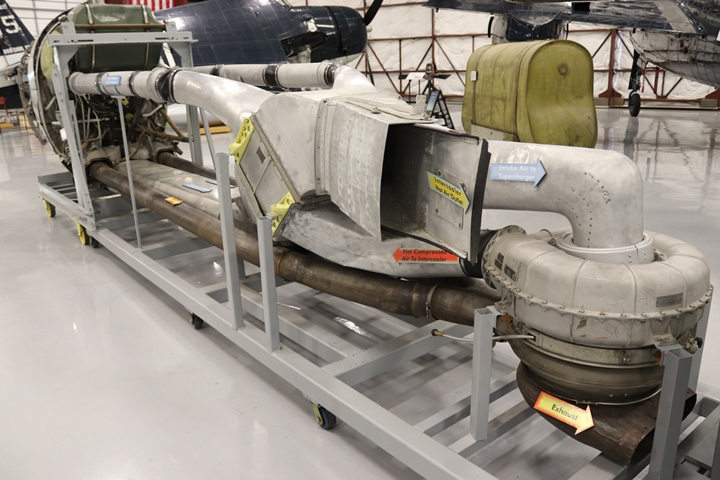
This image shows a complete and complex P-47
turbo supercharger system. The Haynes Stellite turbine buckets may
have been small compared to the rest of the system, but they were a very
important component for proper operation. Author's photo from the
National Museum of World War Two Aircraft in Colorado Springs, CO.
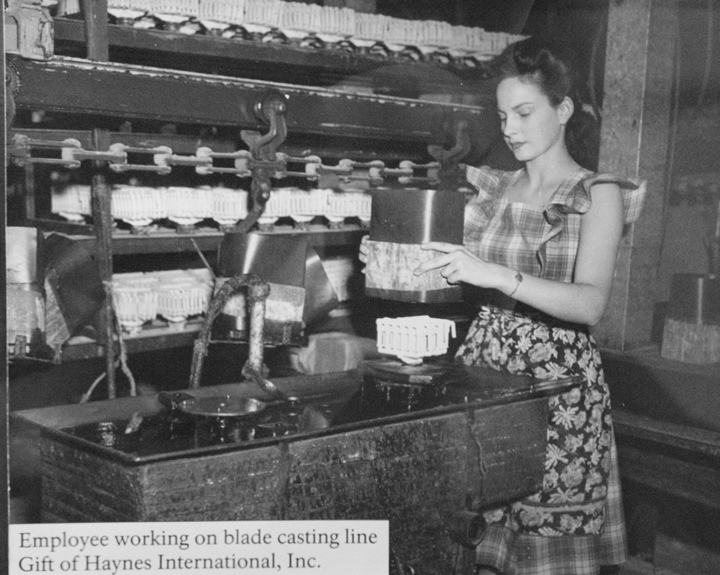
This and the following image are from the
Howard County Historical Museum and show some of the processes involved
in the manufacture of the turbine buckets.
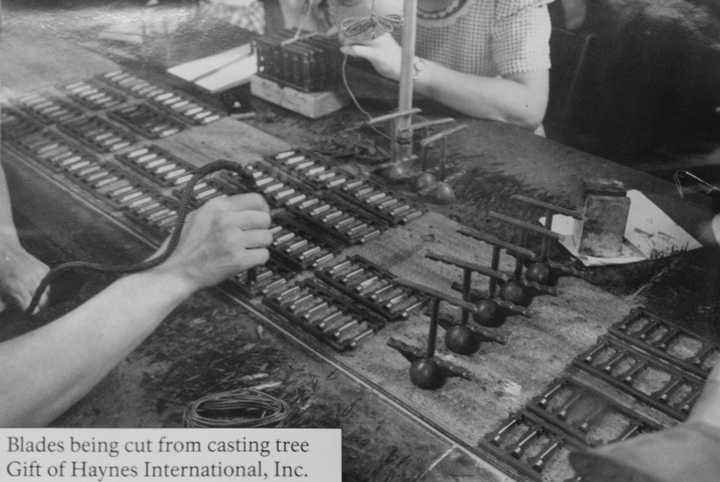
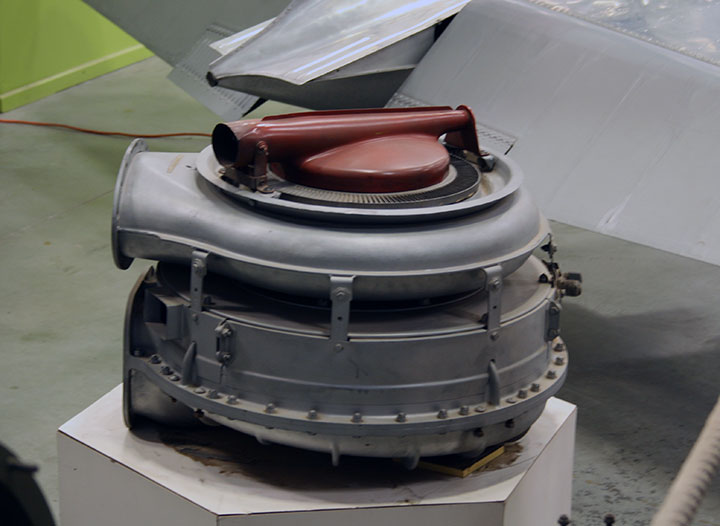
This an example of a GE turbo supercharger that was on display at the
March AFB Museum in Riverside, CA. The red welded sheet metal
component on the top is the cooling cap.
This directed air onto the bucket wheel below it. The small
components on the outside diameter of the bucket wheel are the Haynes Stellite buckets. Hot
exhaust gases at 1,500 deg. Fahrenheit coming from the
aircraft engine entered the intake port and were directed to
the buckets, which spun the bucket wheel, which then spun intake air for
the engine into the bottom section of the compressor, which
compressed the intake air and sent it to the engine's carburetor. This
allowed the aircraft to operate in the rarified air at high altitudes. Author's photo.
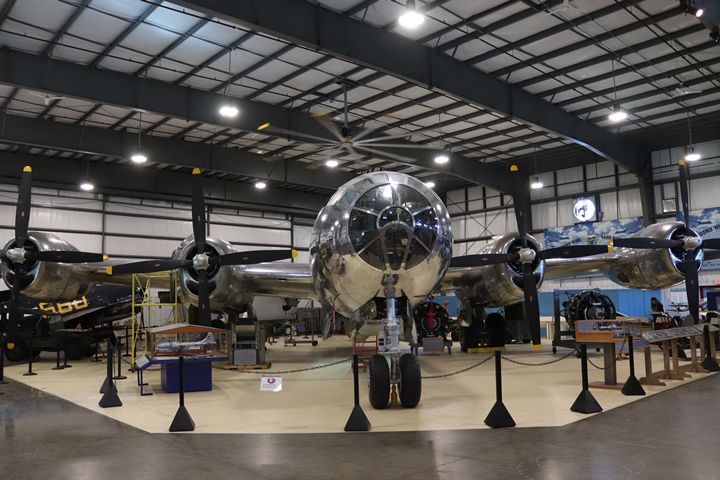
The New England Air Museum in Windsor Locks,
CT built a special display hangar to
display its B-29 named "Jack's Hack." Author's photo.
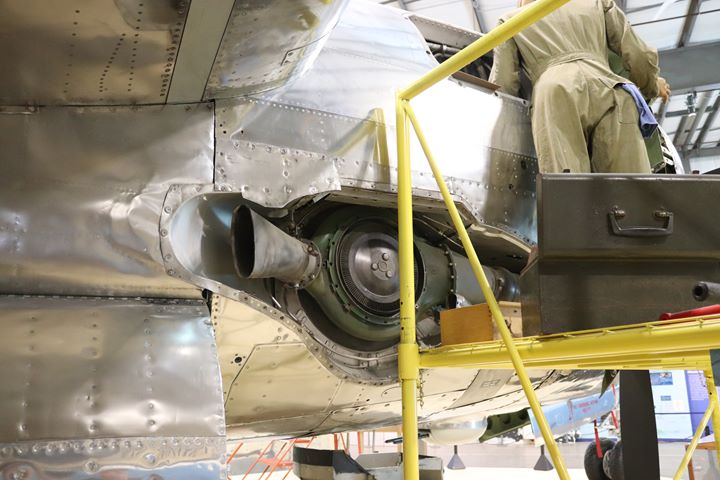
This image shows the location of one of the
two turbo superchargers per engine that were used on the B-29.
Author's photo.
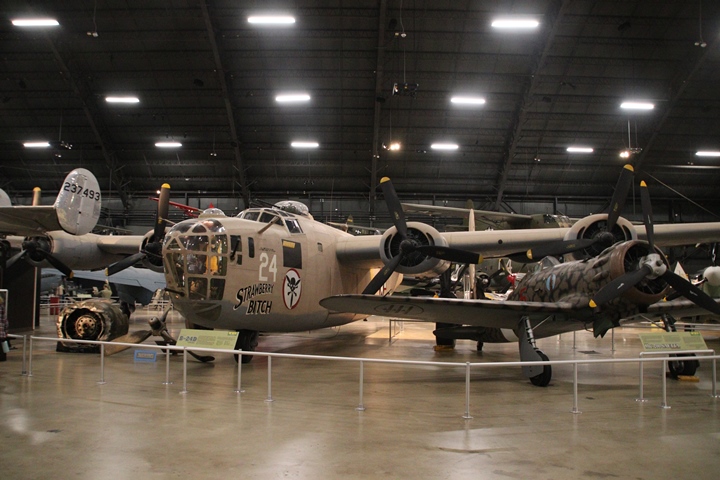
This B-24D is on display at the National
Museum of Air Force. Author's photo.
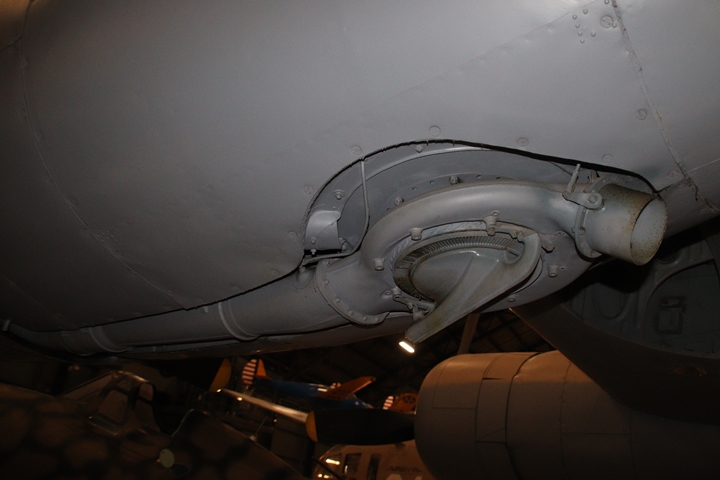
The B-24 had its turbo superchargers mounted
behind the engine and on the bottom of the nacelle similar to the B-17.
Author's photo.
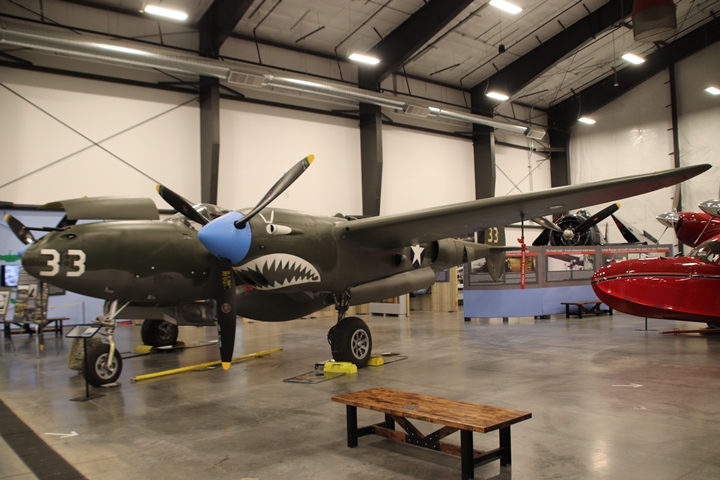
The legendary Lockheed P-38 is most
well-known for the use of the GE turbo supercharger among the USAAF
aircraft that utilized the device. The P-38's twin boom design and
the use of two Allison V-1710 engines made it unique among American
fighter aircraft. This P-38 is part of the flying collection at
the National Museum of World War Two Aircraft in Colorado Springs, CO.
Author's photo.
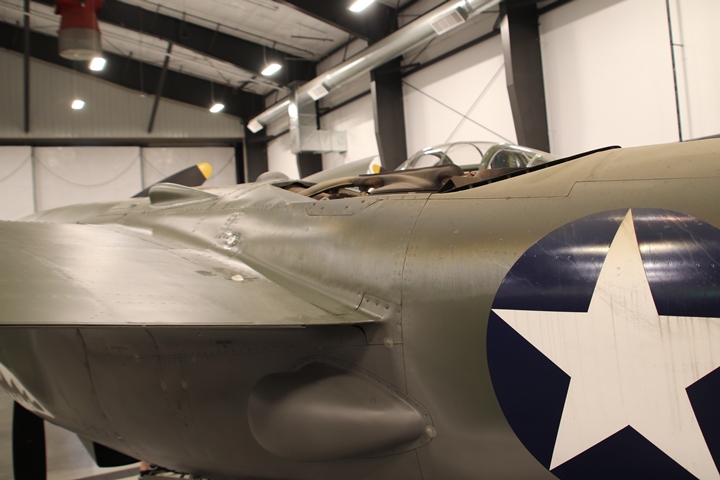
The P-38's turbo superchargers are located behind the engines on top of
the twin booms. This image shows the left engine turbine section.
The aircraft's canopy can be seen in the background. Author's
photo.
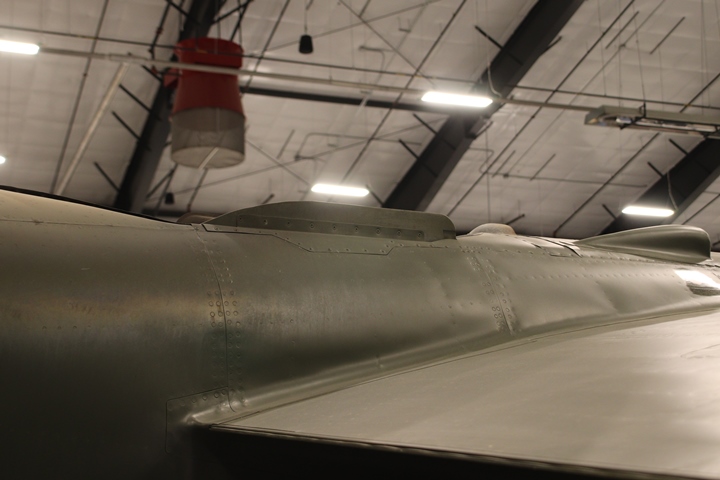
As noted previously, turbine wheels did
disintegrate on occasion for various reasons. With the turbine
wheel on the top of the boom, pieces of the turbine wheel and it buckets
could strike the pilot's cockpit area. The sheet metal guard shown
in this photo was used to deflect the pieces of turbine debris away from
the cockpit. Author's photo.
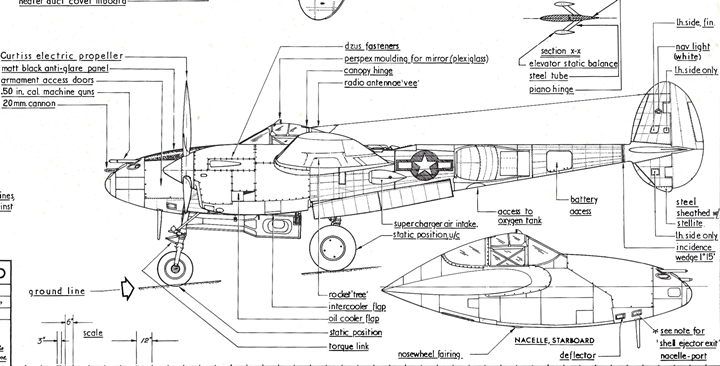
How cool is this? Not only did
the P-38 have two General Electric B-33 super turbo superchargers with
144 Stellite buckets in
each of the turbines, but the P-38 also utilized Stellite to not damage
the bottom of the rudder if it hit the ground during landing. This image has
information on various components in the Lockheed P-38L. On the
far right of the photo at the bottom of the vertical stabilizer is a
small component. The description reads "steel sheathed w/stellite."
This is an excellent example of the hardness and wear resistance of
Stellite.
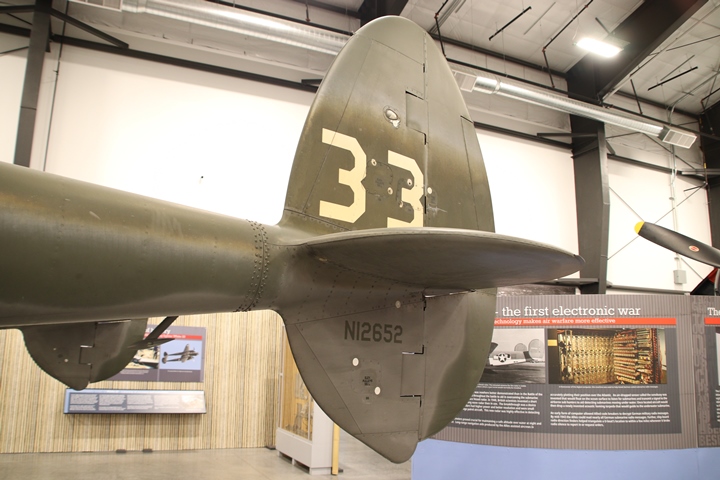
This and the next photo show the Stellite
rudder protectors on the P-38. Author's photo.
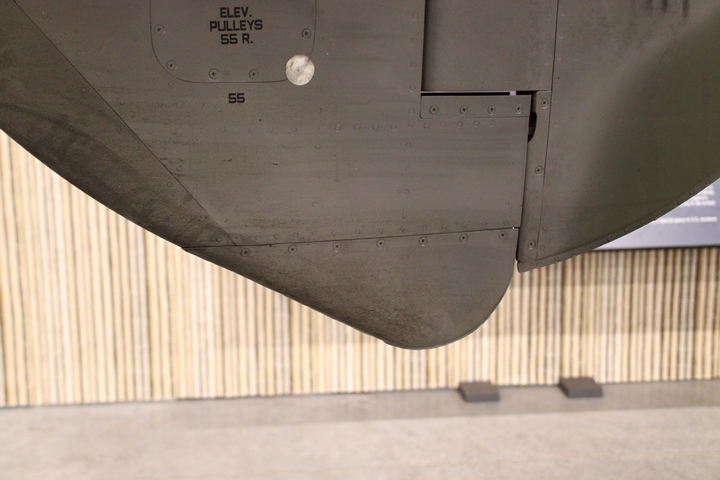
Author's photo.
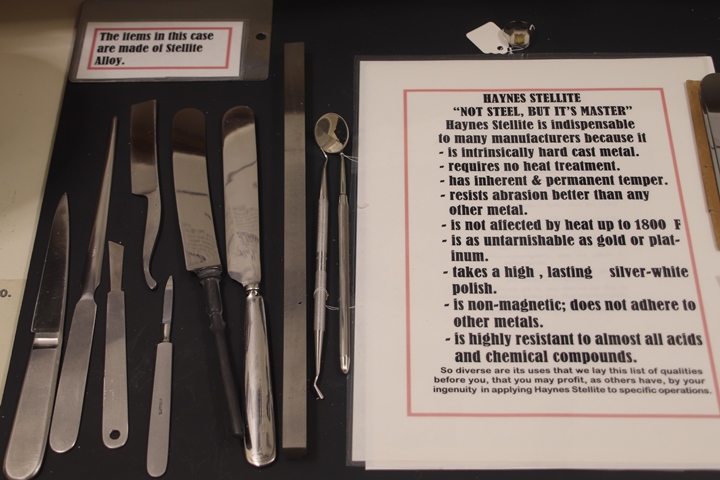
One of the items mentioned in the previous
advertisement was the use of Haynes' alloys for dental instruments for
the U.S. Army Medical Corps. Because the alloys are non-ferrous,
they do not rust. The information sheet with this display at the
Elwood Haynes Museum explains all of the advantages of Haynes products. Author's photo.
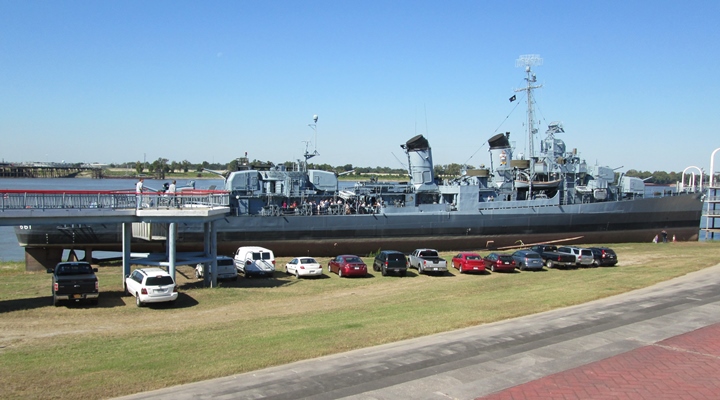
This is Fletcher class World War Two
destroyer is the USS Kidd, located in Baton Rouge, LA. Author's photo.
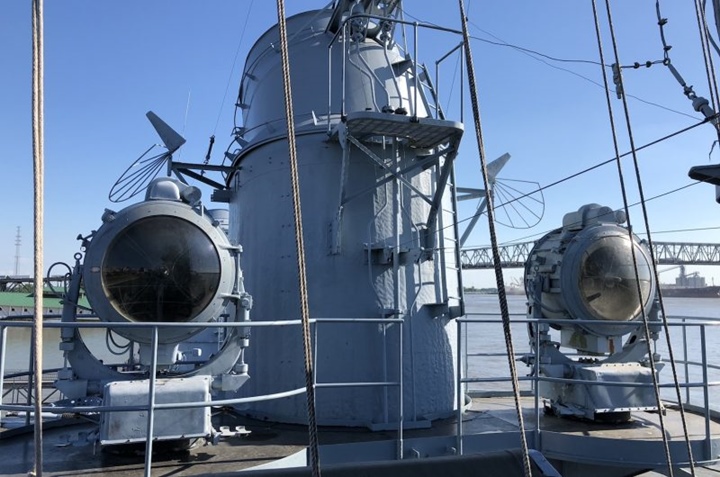
Another product mentioned in the newspaper
advertisement was the use of Haynes alloys as reflectors in U.S.
Navy ship searchlights. The highly reflective alloys used in the reflectors
were shatterproof and were not affected by saltwater corrosion.
Image courtesy of the USS Kidd Veterans Museum.
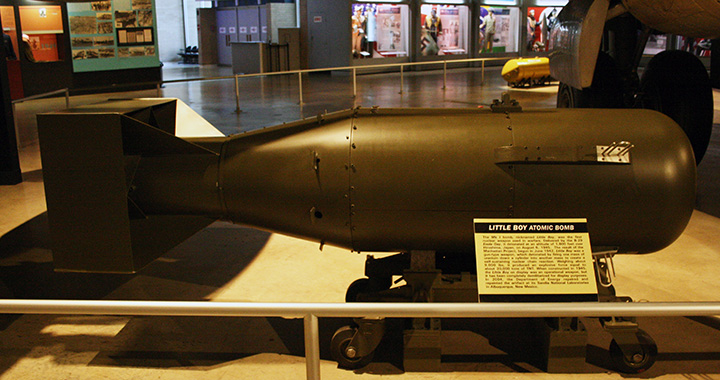
Not mentioned in the newspaper advertisement
was the company's involvement with the Manhattan Project. This was
due to the top secret nature of the project. Most likely the
Haynes non-corrosive alloys were used in the gaseous diffusion plant in
Oak Ridge, TN. This method of extracting the U-235 from the U-238
involved very corrosive hexafluoride. The company's nickel based
alloys would not have been affected by the hexafluoride.
Author's photo.
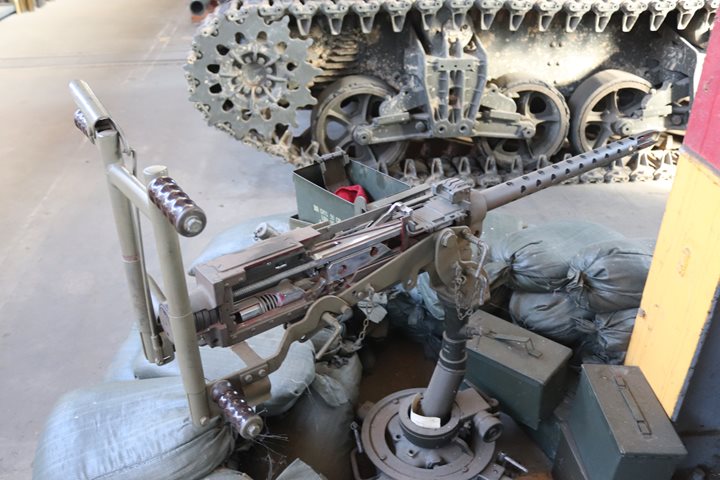
This cut-away of a Browning M2 .50 caliber
machine gun was found in the maintenance shop of the National Armor and
Cavalry Museum at Fort Moore, GA. The aircraft version of the M2
.50 caliber machine gun was the standard armament for all American
fighters and bombers during World War Two. Both fighter pilots and
bomber gunners were losing the accuracy of their .50 caliber machine
guns during combat as the barrels wore out. Experimentation revealed that Haynes Alloy No.
21 gave ten times the life of the liner as the previous type. A
special casting method was developed by the company for the manufacture
of the liners.
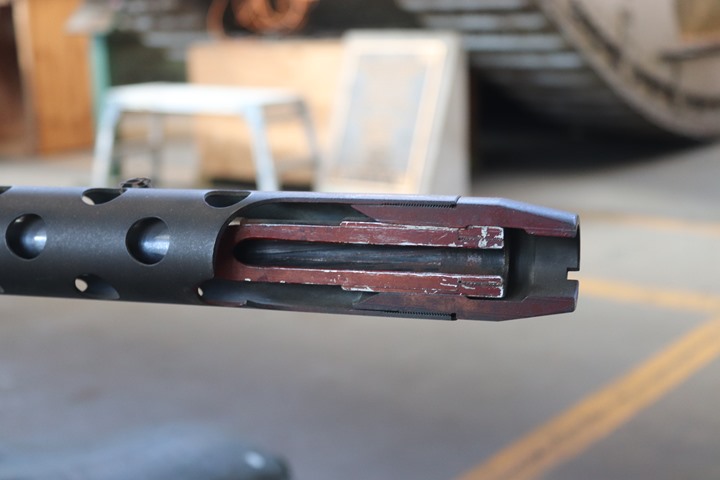
This cut-away of the end of the barrel shows
the inner liner. After the initial testing that showed that Haynes
No. 21 Alloy was ten times better than the original liner material, more
test examples were made and tested in combat. When it was
confirmed
that the Haynes alloy worked as expected, the company received contract 33008-ORD-1677
for $3,797,000 for a production run of the liners. A special casting
process was developed by the company to produce the liners on a mass
production basis.
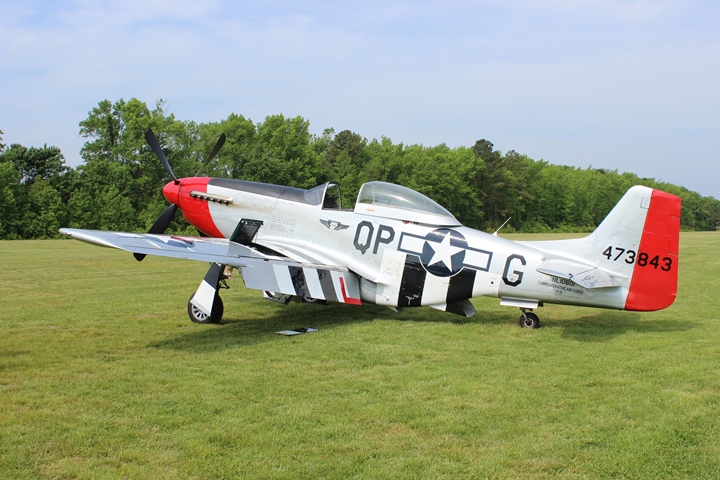
The P-51 was the prominent U.S. Army Air
Forces fighter in the later stage of World War Two. It was armed
with six .50 caliber machine guns. Author's photo.
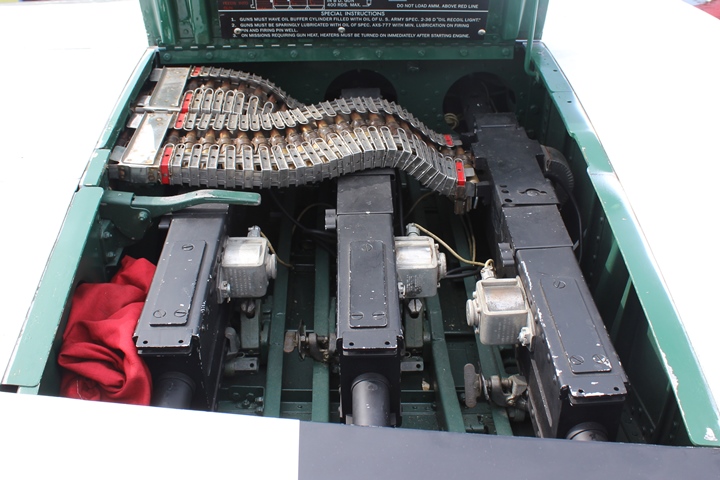
Once mounted in the wings of the aircraft,
the P-51's weapons could not have their barrels changed out until the
aircraft returned from a mission. Stellite No. 21 allowed the
pilots to maintain the accuracy of the weapons for the full load of
ammunition. Author's photo.
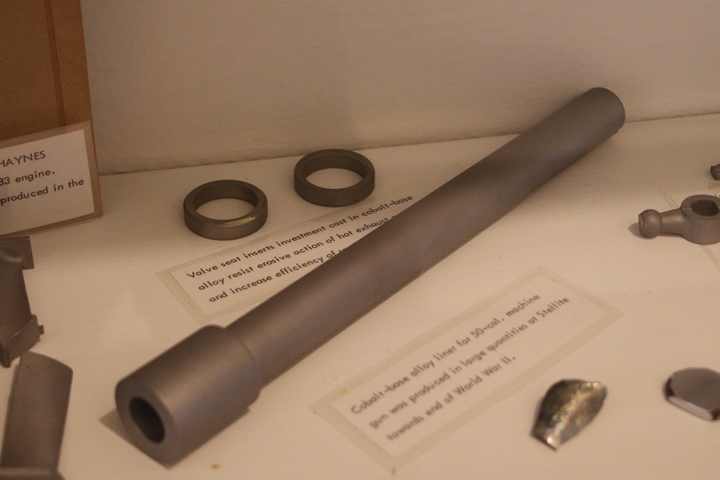
The Elwood Haynes Museum has this .50
caliber liner on display. Author's photo.
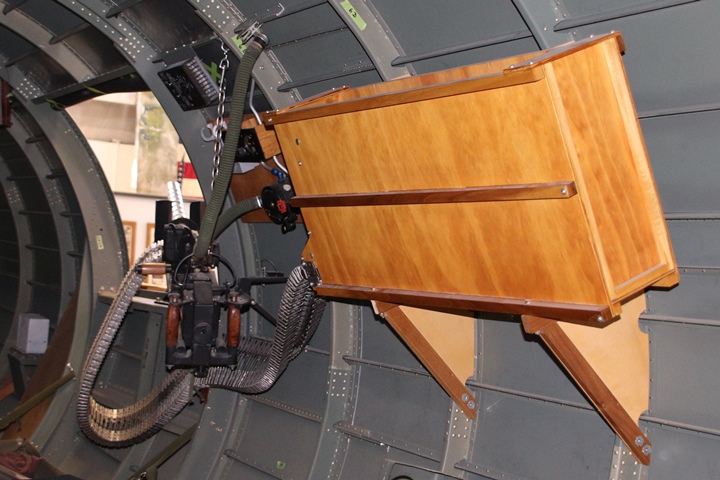
.50 caliber machine guns were used on B-17s
and B-24s in various locations on the aircraft. However, it was
not feasible for a gunner to attempt a barrel change in flight.
This needed to be performed by an ordnance person between flights while
the aircraft was on the ground. On
B-29s, the turret guns were all remote and not accessible to the crew
during flight. The Haynes Stellite No. 21 used in the liners
helped the bomber crews retain the accuracy of their weapons. Author's photo.
The Haynes Stellite Plants:
The original location of Haynes Stellite
Company which was also active during World War Two was located at the intersection of South Lindsay
Street and Markland Avenue in Kokomo, IN. The company called this
the Lindsay Street operation.
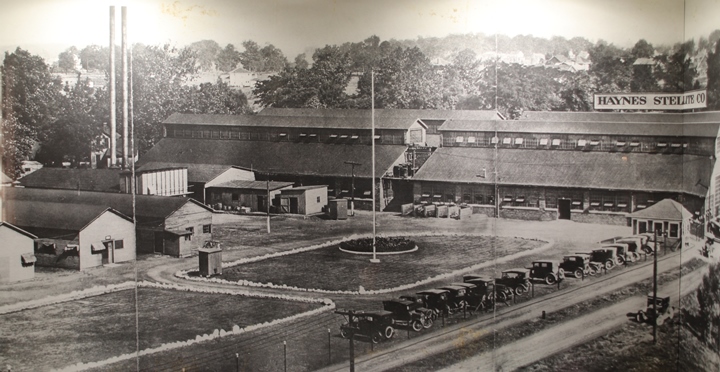
This shows the early Haynes facility on
Lindsay Street. This photo is from the many displays and photos at
the Elwood Haynes Museum.
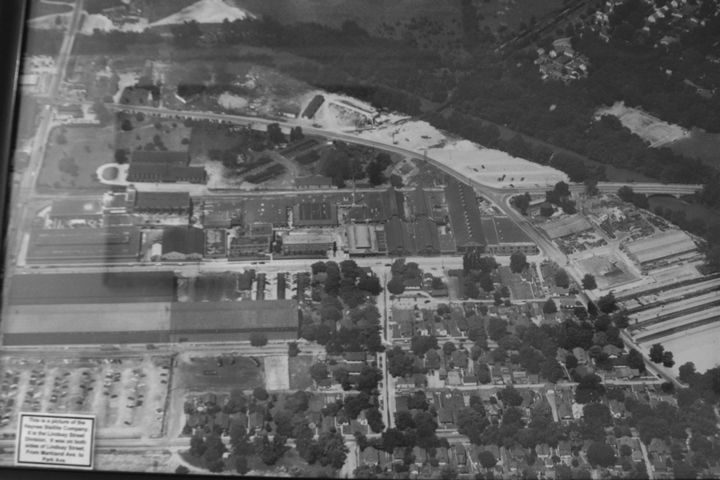
This shows the Haynes Stellite facility on
South Lindsay Street at its peak. The date is unknown but most
likely this is what the facility looked like during World War Two.
This image is looking west. Along the left side of the photo is
Markland Avenue. The road that follows the contour of Wildcat
Creek on the right and upper portion of the photo is Park Avenue.
The Haynes Lindsay Street operation has grown into a facility that is
bounded by Markland Avenue to the south and Park Avenue to the north.
The company parking lot can be seen in the lower left hand corner of the
photo. Haynes was not the only industrial facility in the area.
To the south across Markland Avenue was the location of the former
Continental Steel Company. This and the next photo are from large
photographs on display at the Haynes Museum.
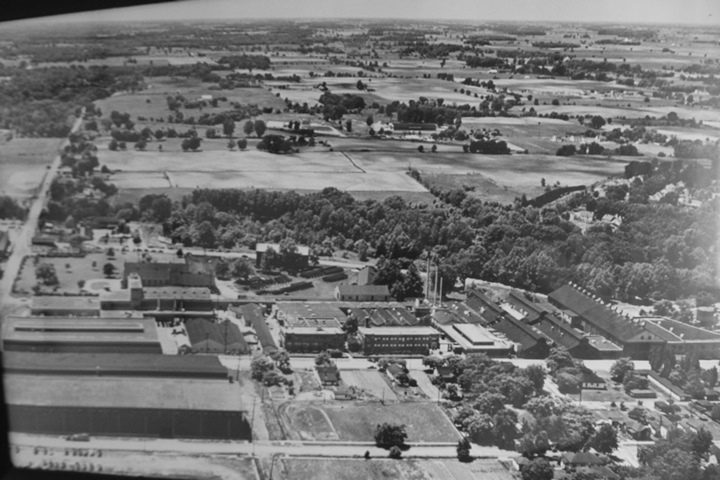
This image gives a closer look at the
Lindsay Street operation. Haynes International no longer has a
presence at this location.
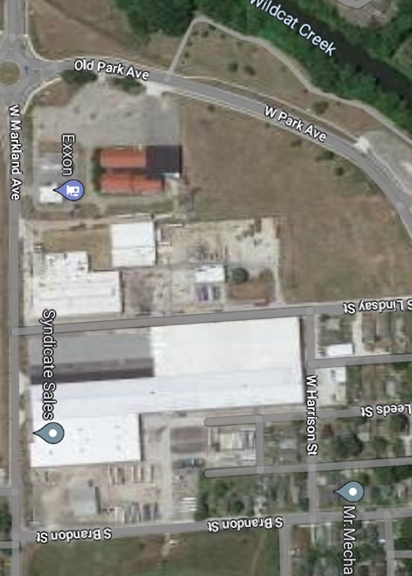
This Google Maps satellite view shows what
remains of the former Haynes factory complex.

This Google Map street view is looking
northeast from Markland Avenue.

This Google Map street view is looking south
along South Lindsay Street.
Haynes International Kokomo Area Plants:
As noted above, Haynes International has remained in the Kokomo area and
has both its world headquarters and a large factory complex.
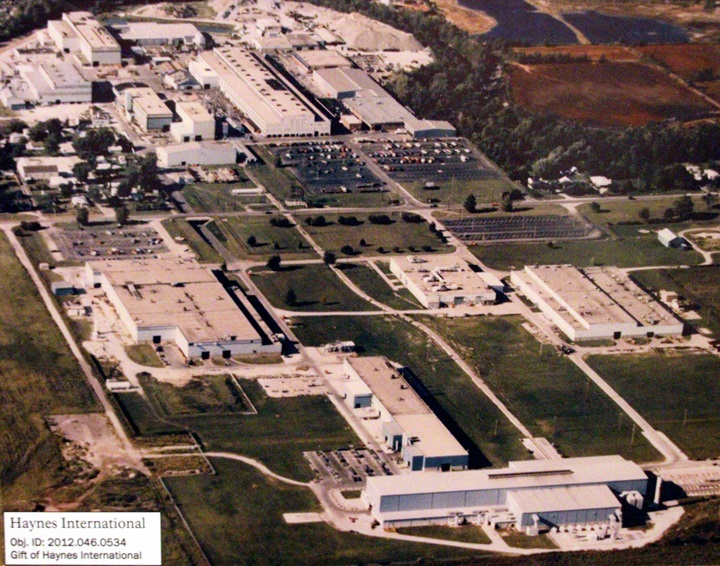
This image of the current Haynes
International factory complex on Kokomo's southwest side is from the
Howard County Historical Museum.
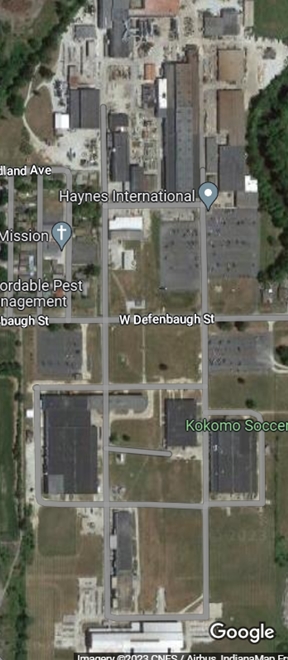
This satellite view also shows the 100 acre complex in southwest
Kokomo on West Defenbaugh Street. The land was purchased for
expansion and new plants in 1945. Image courtesy of Google Maps.
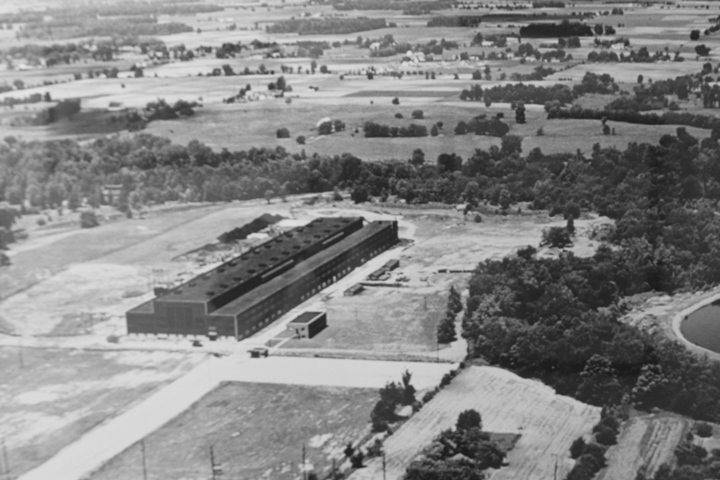
The first building to be built on the new
site was this rolling mill that became operational in 1948. This
image is from the Elwood Haynes Museum.
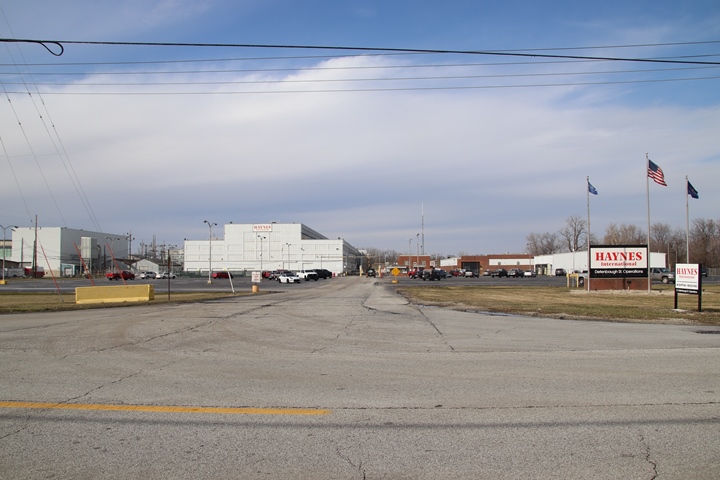
Currently, the rolling mill is still in use
among the many other factories that have been added since 1948.
Author's photo.
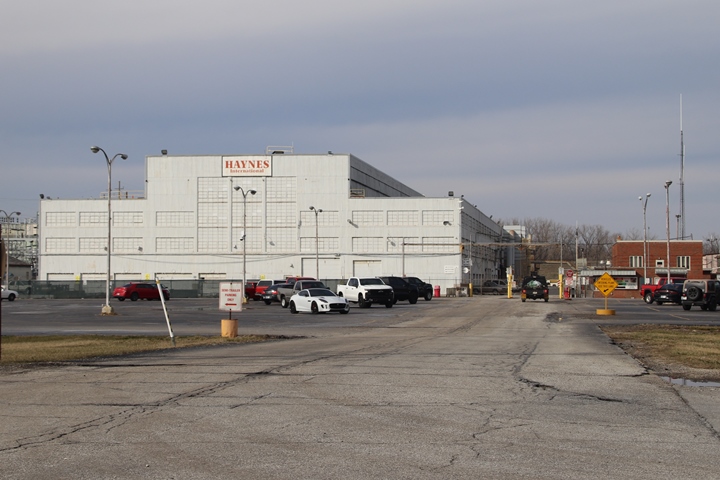
The rolling mill and the windows have been
repainted white. Author's photo.
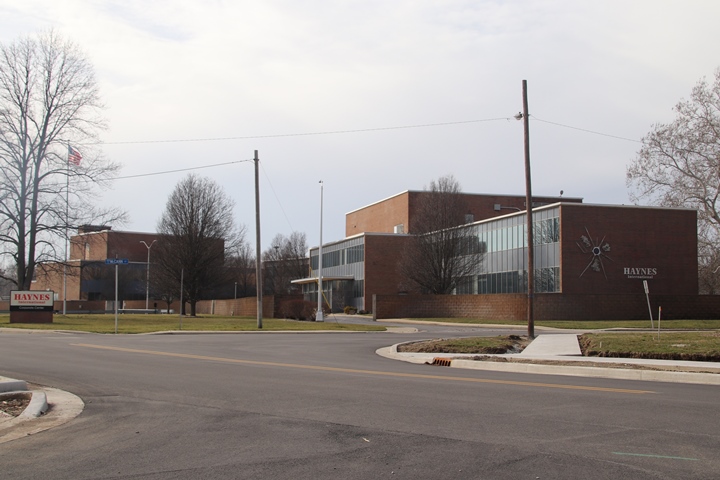
Haynes International Corporate Center is
located on Park Avenue north of the former South Lindsay Street
facility. Author's photo.
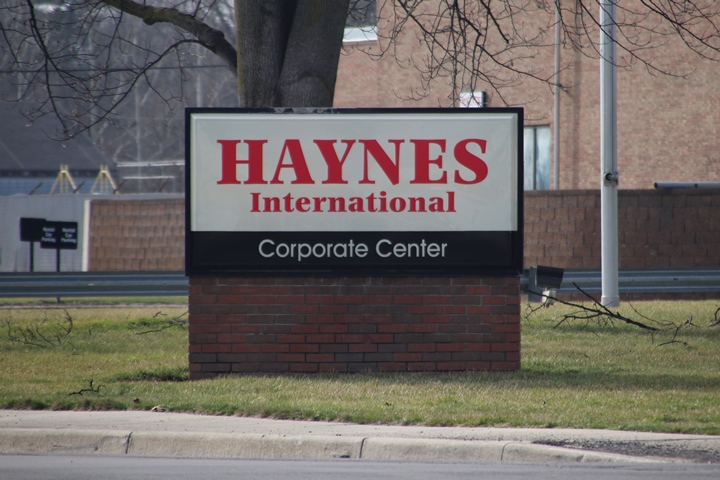
Author's photo.
|































































